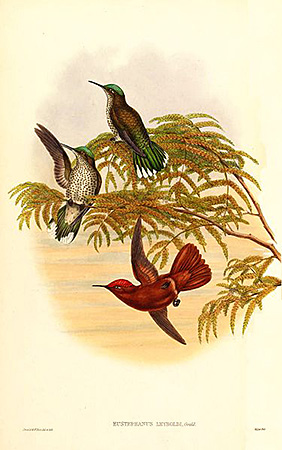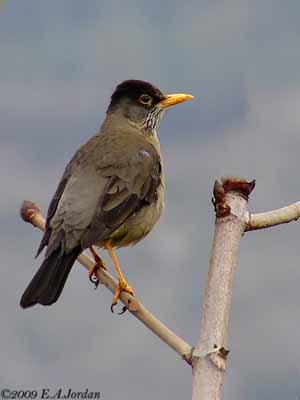
Juan Fernández Firecrown
Sephanoides fernandensis
Apodiformes Order - Trochilidae Family
INTRODUCTION:
The Juan Fernández Firecrown is endemic to Juan Fernández Islands, off Chile. The nominate race is found on Robinson Crusoe Island whereas the extinct subspecies S.f. leyboldi was on Alejandro Selkirk Island.
The Juan Fernández Firecrown frequents forests, thickets and gardens, usually in shady areas. It feeds mainly on nectar from flowers of Dendroseris littoralis (and others) and also takes small insects, especially during summer. It is often observed in the streets of the town San Juan Bautista where these trees are present.
The Juan Fernández Firecrown breeds at mid-elevation (120-660 metres). The cup-shaped nest is placed at tips of twigs in trees, about four metres above the ground.
The Juan Fernández Firecrown is threatened by habitat degradation by humans and introduced herbivorous mammals. Invasive plant species also degrade the quality of the habitat. Introduced predators kill the birds and destroy the nests.
The population is slowly declining and this restricted-range species is currently listed as Critically Endangered.
DESCRIPTION OF THE BIRD:
Biometrics:
Male: Length: 11,5 – 12 cm – Weight: 11 g
Female: Length: 10,5 cm – Weight: 6,8 g
The Juan Fernández Firecrown adult male has chestnut/cinnamon-orange upperparts, underparts and tail, but the wings are dark coppery-grey.
On the head, we can see a patch of flashing iridescent feathers on both forehead and crown.
The straight bill is black. The eyes are dark brown. Legs and feet are blackish.
CALLS AND SONGS: SOUNDS BY XENO-CANTO
The Juan Fernández Firecrown defends strongly its favoured patches of flowers and it often becomes aggressive, vocalizing while hovering in front of an intruder and flashing the iridescent crown feathers. During this aggressive behaviour, it gives shrill, sputtering, raspy calls.
The song includes high-pitched, squeaky notes, dry gravely trills and descending chatters.
BEHAVIOUR IN THE WILD:
The Juan Fernández Firecrown feeds primarily on nectar from numerous flowers. It clings to the flower, especially the endemic Dendroseris littoralis and Rhaphitamnus venustus, and also Cirslum thistles.
Some introduced plants may also be other food sources for this species. Small insects are also eaten, especially during the breeding season.
The Juan Fernández Firecrown usually prefers to forage and feed in shady, sheltered areas.
Both male and female defend aggressively their feeding areas, and the male often guards the most productive flowering plants. Territorial disputes occur when an intruder approaches, involving calls, chases and crow-flashing.
The breeding behaviour of the Juan Fernández Firecrown is poorly known. However, some observations describe two males chasing a single female during the breeding season. At this period, the females need more food than males with egg-development and incubation, involving more aggressive encounters from males guarding their rich feeding areas. The females may be affected by these aggressive interactions involving relatively large energy costs.
The nest is typical of the Family Trochilidae, a small cup-shaped structure built at tips of twigs, about four metres above the ground.
The Juan Fernández Firecrown is sedentary and only moves over the island in search of new feeding territories.
It only performs short-distance flights.
REPRODUCTION OF THIS SPECIES:
The breeding season takes place from September to mid-November.
The female performs alone all the nesting duties. She builds a small, cup-shaped nest about four metres above the ground, mainly in Myrceugenia, but also in other plant species, often Luma apiculata. The nest is built at tips of twigs. It is made of woven fern fibres, mosses and spider cocoon and webs.
She lays two white eggs and incubates alone. The duration is unknown, but this period varies from 14-16 to 22-23 days, depending on the species.
The chicks are fed by regurgitation, usually nectar and small insects.
No more information.
PROTECTION / THREATS / STATUS:
The Juan Fernández Firecrown is affected by habitat degradation, both by humans and herbivorous mammals such as introduced rabbits. The loss of native habitats is also caused by wood harvesting at lower elevations.
Invasive plants are spreading and destroy the native species.
The Juan Fernández Firecrown is also threatened by invasive predators such as rats, cats and coatis, involving the mortality of several birds.
The Austral Thrush has been observed predating firecrown nests. Actually, the firecrowns are very vulnerable during the phase of nocturnal torpor.
Fr: Colibri robinson
Ang: Juan Fernández Firecrown
All: Juan-Fernández-Kolibri
Esp: Colibrí de Juan Fernández
Ita: Capo di fuoco di Juan Fernandez
Nd: Juan-Fernándezkolibrie
Sd: juanfernándezkolibri
Photographer:
Eduardo Andrés Jordan
MIS AVES - AVES DE ARGENTINA
Illustration:
John Gould: 1804-1881
Source: From Gould's 'A Monograph of the Trochilidae or Family of Hummingbirds', Supplement (1880-87) Hart after Gould.
Text by Nicole Bouglouan
Sources:
HANDBOOK OF THE BIRDS OF THE WORLD Vol 5 by Josep del Hoyo-Andrew Elliott-Jordi Sargatal - Lynx Edicions - ISBN: 8487334253
Juan Fernandez Firecrown Hummingbird Species
Arthur Grosset's Birds (Arthur Grosset)
Hummingbirds of the Juan Fernández Islands: natural history, evolution and population status
Conservation of the Juan Fernandez firecrown and its island habitat
Wikipedia, the free encyclopaedia

Females at top
Male in flight at the bottom
John Gould: 1804-1881
The Juan Fernández Firecrown adult female has bluish-green upperparts whereas underparts are white and show green and black spots. The centre of the breast is sometimes uniformly white. The wings are slaty-green. On the tail, central rectrices and outer webs of outer rectrices are blue-green. The outer rectrices have broad, white inner webs.
On the head, the crown is iridescent bluish-purple. Rest of face is mostly bluish-green. Chin and throat are white with dark spots.
The bare parts are similar to those of the male.
The female can sometimes be confused with the non-endemic species present on the island, the Green-backed Firecrown.
The juvenile male has more iridescence on the crown as it is growing.
The juvenile female has more buff underparts than adult female.
SUBSPECIES AND RANGE:
The Juan Fernández Firecrown has two subspecies.
S.f. fernandensis (described above) is found on Robinson Crusoe Island (Juan Fernández Islands).
S.f. leyboldi is extinct. It was found on Alejandro Selkirk Island (Juan Fernández Islands).
The Juan Fernández Firecrown is now treated as monotypic species.
HABITAT:
The Juan Fernández Firecrown frequents forests, thickets and gardens. During summer, the males are often observed in San Juan Bautista, the only town of the island, feeding on nectar at flowering trees Dendroseris littoralis, a critically endangered plant species.
This species feeds mainly on nectar and takes occasionally small insects while hovering around the flowers. It usually prefers shady and sheltered areas white foraging.
Several introduced plants are invading the areas of native plants and eliminate them. The invasive plants are spread by the introduced Austral Thrush.
